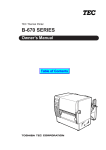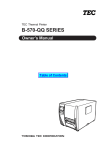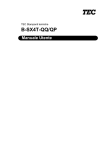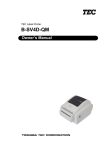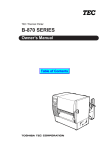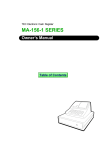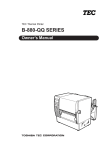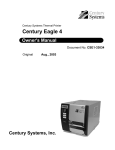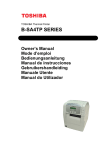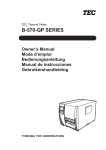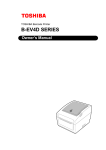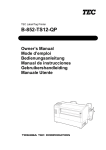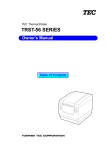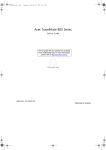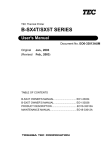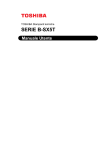Download B-SX5T Series Owner`s Manual - EO1-33036B - 09/17
Transcript
TEC Thermal Printer
B-SX5T SERIES
Owner's Manual
CE Compliance (for EU only)
This product complies with the requirements of EMC and Low Voltage Directives including their
amendments.
VORSICHT:
• Schallemission: unter 70dB (A) nach DIN 45635 (oder ISO 7779)
• Die für das Gerät Vorgesehene Steckdose muß in der Nähe des Gerätes und leicht zugänglich sein.
Centronics is a registered trademark of Centronics Data Computer Corp.
Microsoft is a registered trademark of Microsoft Corporation.
Windows is a trademark of Microsoft Corporation.
As an ENERGY STAR® Partner, TOSHIBA TEC has determined that this
product meets the ENERGY STAR® guidelines for energy efficiency.
-- Outline of the International ENERGY STAR® Office Equipment Program -The International ENERGY STAR® Office Equipment Program is an international program that
promotes energy saving through the penetration of energy efficient computers and other office
equipment. The program backs the development and dissemination of products with functions that
effectively reduce energy consumption. It is an open system in which business proprietors can
participate voluntarily. The targeted products are office equipment such as computers, monitors,
printers, facsimiles, copiers, scanners, and multifunction devices. Their standards and logos are
uniform among participating nations.
ENERGY STAR is a U.S. registered mark.
This equipment has been tested and found to comply with the limits for a Class A digital device,
pursuant to Part 15 of the FCC Rules. These limits are designed to provide reasonable rotection
against harmful interference when the equipment is operated in a commercial environment. This
equipment generates, uses, and can radiate radio frequency energy and, if not installed and sed in
accordance with the instruction manual, may cause harmful interference to radio communications.
Operations of this equipment in a residential area is likely to cause harmful interference in which case
the user will be required to correct the interference at his own expense.
(for USA only)
Changes or modifications not expressly approved by manufacturer for compliance could void the
user’s authority to operate the equipment.
“This Class A digital apparatus meets all requirements of the Canadian Interference-Causing
Equipment Regulations.”
“Cet appareil numérique de la classe A respecte toutes les exigences du Règlement sur le matériel
brouilleur du Canada.”
(for CANADA only)
Copyright © 2003
by TOSHIBA TEC CORPORATION
All Rights Reserved
570 Ohito, Ohito-cho, Tagata-gun, Shizuoka-ken, JAPAN
Safety Summary
ENGLISH VERSION EO1-33036
6DIHW\6XPPDU\
Personal safety in handling or maintaining the equipment is extremely important. Warnings and Cautions
necessary for safe handling are included in this manual. All warnings and cautions contained in this manual
should be read and understood before handling or maintaining the equipment.
Do not attempt to effect repairs or modifications to this equipment. If a fault occurs that cannot be rectified
using the procedures described in this manual, turn off the power, unplug the machine, then contact your
authorised TOSHIBA TEC representative for assistance.
0HDQLQJVRI(DFK6\PERO
This symbol indicates warning items (including cautions).
Specific warning contents are drawn inside the symbol.
(The symbol on the left indicates a general caution.)
This symbol indicates prohibited actions (prohibited items).
Specific prohibited contents are drawn inside or near the symbol.
(The symbol on the left indicates “no disassembling”.)
This symbol indicates actions which must be performed.
Specific instructions are drawn inside or near the ● symbol.
(The symbol on the left indicates “disconnect the power cord plug from the outlet”.)
:$51,1*
$Q\ RWKHU WKDQ WKH
VSHFLILHG $& YROWDJH
LV SURKLELWHG
3URKLELWHG
3URKLELWHG
'LVFRQQHFW
WKH SOXJ
This indicates that there is the risk of death or serious injury if the
machines are improperly handled contrary to this indication.
Do not use voltages other than
the voltage (AC) specified on the
rating plate, as this may cause
fire or electric shock.
3URKLELWHG
If the machines share the same
outlet with any other electrical
appliances that consume large
amounts of power, the voltage
will fluctuate widely each time
these appliances operate. Be sure
to provide an exclusive outlet for
the machine as this may cause
fire or electric shock.
Do not insert or drop metal,
flammable or other foreign
objects into the machines through
the ventilation slits, as this may
cause fire or electric shock.
3URKLELWHG
3URKLELWHG
If the machines are dropped or
their cabinets damaged, first turn
off the power switches and
disconnect the power cord plugs
from the outlet, and then contact
your authorised TOSHIBA TEC
representative for assistance.
Continued use of the machine in
that condition may cause fire or
electric shock.
'LVFRQQHFW
WKH SOXJ
(i)
Do not plug in or unplug the power
cord plug with wet hands as this
may cause electric shock.
Do not place metal objects or
water-filled containers such as
flower vases, flower pots or mugs,
etc. on top of the machines. If
metal objects or spilled liquid enter
the machines, this may cause fire
or electric shock.
Do not scratch, damage or modify
the power cords. Also, do not
place heavy objects on, pull on, or
excessively bend the cords, as this
may cause fire or electrical shock.
Continued use of the machines in
an abnormal condition such as
when the machines are producing
smoke or strange smells may cause
fire or electric shock. In these
cases, immediately turn off the
power switches and disconnect the
power cord plugs from the outlet.
Then, contact your authorised
TOSHIBA TEC representative for
assistance.
Safety Summary
ENGLISH VERSION EO1-33036
'LVFRQQHFW
WKH SOXJ
&RQQHFW D
JURXQGLQJ ZLUH
If foreign objects (metal
fragments, water, liquids) enter
the machines, first turn off the
power switches and disconnect
the power cord plugs from the
outlet, and then contact your
authorised TOSHIBA TEC
representative for assistance.
Continued use of the machine in
that condition may cause fire or
electric shock.
Ensure that the equipment is
properly grounded. Extension
cables should also be grounded.
Fire or electric shock could
occur on improperly grounded
equipment.
'LVFRQQHFW
WKH SOXJ
1R
GLVDVVHPEOLQJ
When unplugging the power cords,
be sure to hold and pull on the plug
portion. Pulling on the cord portion
may cut or expose the internal wires
and cause fire or electric shock.
Do not remove covers, repair or
modify the machine by yourself.
You may be injured by high
voltage, very hot parts or sharp
edges inside the machine.
This indicates that there is the risk of personal Injury or damage to
&$87,21 objects if the machines are improperly handled contrary to this indication.
Precautions
The following precautions will help to ensure that this machine will continue to function correctly.
● Try to avoid locations that have the following adverse conditions:
* Temperatures out of the specification
* Direct sunlight
* High humidity
* Shared power source
* Excessive vibration
* Dust/Gas
● The cover should be cleaned by wiping with a dry cloth or a cloth slightly dampened with a mild
detergent solution. NEVER USE THINNER OR ANY OTHER VOLATILE SOLVENT on the plastic
covers.
● USE ONLY TOSHIBA TEC SPECIFIED paper and ribbons.
● DO NOT STORE the paper or ribbons where they might be exposed to direct sunlight, high
temperatures, high humidity, dust, or gas.
● Ensure the printer is operated on a level surface.
● Any data stored in the memory of the printer could be lost during a printer fault.
● Try to avoid using this equipment on the same power supply as high voltage equipment or equipment
likely to cause mains interference.
● Unplug the machine whenever you are working inside it or cleaning it.
● Keep your work environment static free.
● Do not place heavy objects on top of the machines, as these items may become unbalanced and fall
causing injury.
● Do not block the ventilation slits of the machines, as this will cause heat to build up inside the
machines and may cause fire.
● Do not lean against the machine. It may fall on you and could cause injury.
● Care must be taken not to injure yourself with the printer paper cutter.
● Unplug the machine when it is not used for a long period of time.
● Place the machine on a stable and level surface.
Request Regarding Maintenance
●
●
●
Utilize our maintenance services.
After purchasing the machine, contact your authorised TOSHIBA TEC representative for assistance
once a year to have the inside of the machine cleaned. Otherwise, dust will build up inside the
machines and may cause a fire or a malfunction. Cleaning is particularly effective before humid rainy
seasons.
Our preventive maintenance service performs the periodic checks and other work required to maintain
the quality and performance of the machines, preventing accidents beforehand.
For details, please consult your authorised TOSHIBA TEC representative for assistance.
Using insecticides and other chemicals
Do not expose the machines to insecticides or other volatile solvents. This will cause the cabinet or
other parts to deteriorate or cause the paint to peel.
( ii )
ENGLISH VERSION EO1-33036
TABLE OF CONTENTS
Page
1.
PRODUCT OVERVIEW ........................................................................................................E1-1
1.1
1.2
1.3
1.4
1.5
2.
Introduction ..................................................................................................................E1-1
Features.......................................................................................................................E1-1
Unpacking ....................................................................................................................E1-1
Accessories .................................................................................................................E1-2
Appearance..................................................................................................................E1-3
1.5.1 Dimensions .................................................................................................................. E1-3
1.5.2 Front View.................................................................................................................... E1-3
1.5.3 Rear View .................................................................................................................... E1-3
1.5.4 Operation Panel........................................................................................................... E1-4
1.5.5 Interior.......................................................................................................................... E1-4
PRINTER SETUP..................................................................................................................E2-1
2.1
2.2
2.3
2.4
2.5
2.6
3.
Precautions ..................................................................................................................E2-1
Procedure before Operation .........................................................................................E2-2
Fitting the Fan Filter .....................................................................................................E2-2
Connecting the Cables to Your Printer .........................................................................E2-3
Connecting the Power Cord .........................................................................................E2-4
Turning the Printer ON/OFF .........................................................................................E2-5
2.6.1 Turning ON the Printer................................................................................................. E2-5
2.6.2 Turning OFF the Printer............................................................................................... E2-5
2.7 Loading the Media........................................................................................................E2-6
2.8 Loading the Ribbon ....................................................................................................E2-12
2.9 Inserting the Optional PCMCIA Cards ........................................................................E2-14
2.10 Test Print....................................................................................................................E2-15
ON LINE MODE ....................................................................................................................E3-1
4.
3.1 Operation Panel ...........................................................................................................E3-1
3.2 Operation .....................................................................................................................E3-2
3.3 Reset............................................................................................................................E3-2
3.4 Dump Mode..................................................................................................................E3-3
MAINTENANCE....................................................................................................................E4-1
4.1
5.
Cleaning.......................................................................................................................E4-1
4.1.1 Print Head/Platen/Sensors .......................................................................................... E4-1
4.1.2 Covers and Panels ...................................................................................................... E4-2
4.1.3 Optional Cutter Module................................................................................................ E4-3
Care/Handling of the Media and Ribbon.......................................................................E4-3
4.2
TROUBLESHOOTING ..........................................................................................................E5-1
5.1
5.2
5.3
5.4
Error Messages............................................................................................................E5-1
Possible Problems........................................................................................................E5-2
Removing Jammed Media............................................................................................E5-3
Threshold Setting .........................................................................................................E5-4
ENGLISH VERSION EO1-33036
APPENDIX 1 SPECIFICATIONS...............................................................................................EA1-1
A1.1 Printer ........................................................................................................................EA1-1
A1.2 Options ......................................................................................................................EA1-2
A1.3 Media.........................................................................................................................EA1-2
A1.3.1 Media Type.....................................................................................................EA1-2
A1.3.2 Detection Area of the Transmissive Sensor ....................................................EA1-3
A1.3.3 Detection Area of the Reflective Sensor .........................................................EA1-4
A1.3.4 Effective Print Area .........................................................................................EA1-4
A1.4 Ribbon .......................................................................................................................EA1-5
APPENDIX 2 MESSAGES AND LEDS .....................................................................................EA2-1
APPENDIX 3 INTERFACE ........................................................................................................EA3-1
APPENDIX 4 PRINT SAMPLES................................................................................................EA4-1
GLOSSARIES
INDEX
WARNING!
This is a Class A product. In a domestic environment this product may cause radio interference in
which case the user may be required to take adequate measures.
CAUTION!
1. This manual may not be copied in whole or in part without prior written permission of TOSHIBA TEC.
2. The contents of this manual may be changed without notification.
3. Please refer to your local Authorised Service representative with regard to any queries you may have in
this manual.
1. PRODUCT OVERVIEW
ENGLISH VERSION EO1-33036
1.1 Introduction
1. PRODUCT OVERVIEW
1.1 Introduction
Thank you for choosing the TEC B-SX5T series thermal printer. This
Owner’s Manual contains from general set-up through how to confirm
the printer operation using a test print, and should be read carefully to
help gain maximum performance and life from your printer. For most
queries please refer to this manual and keep it safe for future reference.
Please contact your TOSHIBA TEC representative for further
information concerning this manual.
1.2 Features
This printer has the following features:
• The print head block can be opened providing smooth loading of
media and ribbon.
• Various kinds of media can be used as the media sensors can be
moved from the centre to the left edge of the media.
• The strip module, ribbon saving module, and expansion I/O interface
board are provided on this printer as standard.
• When the optional interface board is installed, Web functions such as
remote maintenance and other advanced network features are
available.
• Superior hardware, including the specially developed 12 dots/mm
(306 dots/inch) thermal print head which will allow very clear print at
a printing speed of 76.2 mm/sec. (3 inches/sec.), 127.0 mm/sec. (5
inches/sec.), or 203.2 mm/sec. (8 inches/sec.).
• Besides the optional Cutter Module, there are also an optional
PCMCIA Interface Board, LAN Interface Board, and the USB
Interface Board.
1.3 Unpacking
Unpack the printer as per the Unpacking Instructions supplied with the
printer.
NOTES:
1. Check for damage or
scratches on the printer.
However, please note that
TOSHIBA TEC shall have no
liability for any damage of
any kind sustained during
transportation of the product.
2. Keep the cartons and pads
for future transportation of
the printer.
E1- 1
1. PRODUCT OVERVIEW
ENGLISH VERSION EO1-33036
1.4 Accessories
1.4
Accessories
When unpacking the printer, please make sure all the following
accessories are supplied with the printer.
US Power Cord (1 pc.)
EU Power Cord (1 pc.)
CD-ROM (1 pc.)
Fan Filter (1 pc.)
Rewinder Guide Plate (1 pc.)
SMW-4x8 Sems Screws (2 pcs.)
(P/No. FBCB0030203)
QQ model only
QQ (P/No.: 7FM00332100)
QP (P/No.: 7FM00256100)
(P/No.: FMBD0034501)
Warranty Disclaimer Sheet (1 sheet)
QQ-US model only
E1- 2
(P/No.EKA-0030001)
QP model only
(P/No. FMBB0036801)
(P/No.: X0-00161000)
1. PRODUCT OVERVIEW
ENGLISH VERSION EO1-33036
1.5 Appearance
1.5 Appearance
291291
(11.5)
460460
(18.1)
308
1.5.1 Dimensions
The names of the parts or units introduced in this section are used in the
following chapters.
308
(12.1)
Dimensions in mm (inches)
1.5.2 Front View
LCD Message Display
Top Cover
Operation Panel
Supply Window
Media Outlet
1.5.3 Rear View
Parallel Interface
Connector (Centronics)
PCMCIA Card Slot (Option),
USB Connector (Option), or
LAN Connector (Option)
USB Connector
(Option) or LAN
Connector (Option)
Serial Interface
Connector (RS-232C)
Expansion I/O
Interface Connector
AC Power Inlet
E1- 3
Power Switch
: OFF
|: ON
{
1. PRODUCT OVERVIEW
ENGLISH VERSION EO1-33036
1.5 Appearance
LCD Message Display
1.5.4 Operation Panel
POWER LED
(Green)
ON LINE LED
(Green)
ERROR LED
(Red)
[FEED] key
[PAUSE] key
[RESTART] key
Please see Section 3.1 for further information about the Operation Panel.
1.5.5 Interior
Ribbon Stopper
Locking Ring
Supply Holder
Print Head Block
Supply Shaft
Print Head
Platen
Take-up Spool
Head Lever
Ribbon Shaft
E1- 4
2. PRINTER SETUP
ENGLISH VERSION EO1-33036
2.1 Precautions
2. PRINTER SETUP
This section outlines the procedures to setup your printer prior to its
operation. The section includes precautions, connecting cables,
assembling accessories, loading media and ribbon, inserting the optional
memory card, and performing a test print.
2.1 Precautions
To insure the best operating environment, and to assure the safety of the
operator and the equipment, please observe the following precautions.
•
Operate the printer on a stable, level, operating surface in a location
free from excessive humidity, high temperature, dust, vibration or
direct sunlight.
•
Keep your work environment static free. Static discharge can cause
damage to delicate internal components.
•
Make sure that the printer is connected to a clean source of AC
Power and that no other high voltage devices that may cause line
noise interference are connected to the same mains.
•
Assure that the printer is connected to the AC mains with a threeprong power cable that has the proper ground (earth) connection.
•
Do not operate the printer with the cover open. Be careful not to
allow fingers or articles of clothing to get caught into any of the
moving parts of the printer especially the optional cutter mechanism.
•
Make sure to turn off the printer power and to remove the power cord
from the printer whenever working on the inside of the printer such
as changing the ribbon or loading the media, or when cleaning the
printer.
•
For best results, and longer printer life, use only TOSHIBA TEC
recommended media and ribbons.
•
Store the media and ribbons in accordance with their specifications.
•
This printer mechanism contains high voltage components; therefore
you should never remove any of the covers of the machine as you
may receive an electrical shock. Additionally, the printer contains
many delicate components that may be damaged if accessed by
unauthorised personnel.
•
Clean the outside of the printer with a clean dry cloth or a clean cloth
slightly dampened with a mild detergent solution.
•
Use caution when cleaning the thermal print head as it may become
very hot while printing. Wait until it has had time to cool before
cleaning. Use only the TOSHIBA TEC recommended print head
cleaner to clean the print head.
•
Do not turn off the printer power or remove the power plug while the
printer is printing or while the ON LINE lamp is blinking.
E2- 1
2. PRINTER SETUP
ENGLISH VERSION EO1-33036
2.2 Procedure before Operation
2.2 Procedure before
Operation
NOTE:
To communicate with the host
computer, one of the following
cables is required.
(1) RS-232C cable: 25 pins
(2) Centronics cable: 36 pins
(3) USB: B plug (Option)
(4) LAN: 10 Base-T or 100
Base-TX (Option)
This section describes the outline of the printer setup.
1.
Unpack the accessories and printer from the box.
2.
Refer to Safety Precautions in this manual and set up the printer at a
proper location.
3.
Fit the Fan Filter to the printer. (Refer to Section 2.3.)
4.
The host computer must have a serial, Centronics parallel, USB or
LAN port. (Refer to Section 2.4.)
5.
Be sure to insert the power cord plug into an AC outlet. (Refer to
Section 2.5.)
6.
Load the media. (Refer to Section 2.7.)
7.
Adjust the position of the Feed Gap Sensor or Black Mark Sensor
depending on the media being used. (Refer to Section 2.7.)
8.
Load the ribbon. (Refer to Section 2.8.)
9.
Turn the power ON. (Refer to Section 2.6.)
10. Perform a test print. (Refer to Section 2.10.)
11. Install the Printer Drivers. (Refer to the Printer Driver Manual.)
2.3 Fitting the Fan Filter
When installing the printer, it is important to ensure that the Fan Filter is
attached before using the printer.
The Fan Filter consists of 2 parts:
(1) Filter Pad
(2) Filter Retainer
To fit the Fan Filter, put the Filter Pad inside the Filter Retainer and
simply press into place as shown in the diagram below, ensuring
connecting pins are aligned with the connecting holes.
Filter Pad
Snap On
Filter Retainer
E2- 2
Snap On
2. PRINTER SETUP
ENGLISH VERSION EO1-33036
2.4 Connecting the Cables to Your Printer
2.4 Connecting the
Cables to Your
Printer
The following paragraphs outline how to connect the cables from the
printer to your host computer, and will also show how to make cable
connections to other devices. Depending on the application software
you use to print labels, there are 4 possibilities for connecting the
printer to your host computer. These are:
• A serial cable connection between the printer’s RS-232 serial
connector and one of your host computer’s COM ports.
(Refer to APPENDIX 3.)
• A parallel cable connection between the printer’s standard parallel
connector and your host computer’s parallel port (LPT).
• An Ethernet connection using the optional LAN board.
• A USB cable connection between the printer’s optional USB
connector and your host computer’s USB port. (Conforming to
USB 1.1)
NOTES:
1. The picture on the right shows
the layout of the interface
connectors when the options
are fully installed. It may be
different depending on your
system configuration.
2. The USB interface and LAN
interface cannot be used at the
same time.
The diagram below shows all the possible cable connections to the
current version of the printer.
g, h, or i
gori
c
d
f
c Parallel Interface Connector (Centronics)
d Serial Interface Connector (RS-232C)
e Expansion I/O Interface Connector
f Power Inlet
g USB Interface Connector (Option)
h PCMCIA Card Slot (Option)
i LAN Interface Connector (Option)
E2- 3
e
2. PRINTER SETUP
ENGLISH VERSION EO1-33036
2.5 Connecting the Power Cord
2.5 Connecting the
Power Cord
CAUTION!
1. Make sure that the printer
Power Switch is turned to
the OFF position ( )
before connecting the
Power Cord to prevent
possible electric shock or
damage to the printer.
2. Use only the Power Cord
supplied with the printer.
Use of any other cord
may cause electric shock
or fire.
3. Connect the Power Cord
to a supply outlet with a
properly grounded
(earthed) connection.
{
1. Make sure that the printer Power Switch is in the OFF ( ) position.
{
Power Switch
2. Connect the Power Cord to the printer as shown in the figure below.
Power Cord
3. Plug the other end of the Power Cord into a grounded outlet as shown
in the figure below.
Power Cord
[QQ Type]
E2- 4
Power Cord
[QP Type]
2. PRINTER SETUP
ENGLISH VERSION EO1-33036
2.6 Turning the Printer ON/OFF
2.6 Turning the Printer
ON/OFF
When the printer is connected to your host computer it is good practice to
turn the printer ON before turning on your host computer and turn OFF
your host computer before turning off the printer.
2.6.1 Turning ON the Printer 1. To turn ON the printer power, press the Power Switch as shown in the
CAUTION!
diagram below. Note that ( | ) is the power ON side of the switch.
Use the power switch to turn
the printer On/Off. Plugging
or unplugging the Power
Cord to turn the printer
On/Off may cause fire, an
electric shock, or damage to
the printer.
Power Switch
NOTE:
If a message other than ON
LINE appears on the display or
the ERROR LED lamp is
illuminated, go to Section 5.1,
Error Messages.
2. Check that the ON LINE message appears in the LCD Message
Display and that the ON LINE and POWER LED lights are
illuminated.
2.6.2 Turning OFF the Printer 1. Before turning off the printer Power Switch verify that the ON LINE
CAUTION!
1. Do not turn off the printer
power while the media is
being printed as this may
cause a paper jam or
damage to the printer.
2. Do not turn off the printer
power while the ON LINE
lamp is blinking as this
may cause damage to
your computer.
message appears in the LCD Message Display and that the ON LINE
LED light is on and is not flashing.
2. To turn OFF the printer power press the Power Switch as shown in the
diagram below. Note that ( ) is the power OFF side of the switch.
{
Power Switch
E2- 5
2. PRINTER SETUP
ENGLISH VERSION EO1-33036
2.7 Loading the Media
2.7 Loading the Media
WARNING!
1. Do not touch any moving
parts. To reduce the risk
of fingers, jewellery,
clothing, etc., being
drawn into the moving
parts, be sure to load the
media once the printer
has stopped moving
completely.
2. The Print Head becomes
hot immediately after
printing. Allow it to cool
before loading the media.
3. To avoid injury, be careful
not to trap your fingers
while opening or closing
the cover.
CAUTION!
Be careful not to touch the
Print Head Element when
raising the Print Head Block.
Failure to do this may cause
missing dots by static
electricity or other print quality
problems.
NOTES:
1. When the Head Lever is
turned to Free position, the
Print Head is raised.
2. To allow printing the Head
Lever must be set to Lock
position. (This ensures that
the Print Head is closed.)
There are two head pressure
levels in the Lock position.
Set the Head Lever depending
on the media type:
Position : Labels
Position : Tags
However, proper position
may differ depending on
media. For details, refer to
TOSHIBA TEC authorised
service representative.
3. Do not turn the Locking Ring
counter-clockwise too far or it
may come off the Supply
Holder.
c
d
The following procedure shows the steps to properly load the media into
the printer so that it feeds straight and true through the printer.
The printer prints both labels and tags.
1. Turn off the power and open the Top Cover.
2. Turn the Head Lever to Free position, then release the Ribbon Shaft
Holder Plate.
3. Open the Print Head Block.
Print Head Block
Top Cover
Head Lever
Ribbon Shaft
Holder Plate
CAUTION!
When loading or replacing the media or a ribbon, be careful not to
damage the print head with a hard object like a watch or a ring.
Care must be taken not to allow
the metal or glass part of a watch
to touch the print head edge.
Care must be taken not to allow
a metal object like a ring to touch
the print head edge.
Since the print head element can be easily damaged by shock, please
treat it carefully by not hitting a hard object against it.
4. Turn the Locking Ring counterclockwise and remove the Supply
Holder from the Supply Shaft.
Locking Ring
Supply Shaft
Supply Holder
E2- 6
2. PRINTER SETUP
ENGLISH VERSION EO1-33036
2.7 Loading the Media
2.7 Loading the Media
(Cont.)
NOTE:
Do not over-tighten the Locking
Ring of the Supply Holder.
5.
6.
7.
Put the media on the Supply Shaft.
Pass the media around the Damper, then pull the media towards the
front of the printer.
Align the projection of the Supply Holder with the groove of the
Supply Shaft, and push the Supply Holder against the media until the
media is held firmly in place. This will centre the media
automatically.
Then turn the Locking Ring clockwise to secure the Supply Holder.
Groove
Damper
Supply Holder
Projection
Media
Supply Shaft
In case of a label rolled with
the print side facing inside.
Media
8.
9.
Locking Ring
In case of a label rolled with
the print side facing outside.
Damper
Place the media between the Media Guides, adjust the Media Guides
to the media width, and tighten the Locking Screw.
Check that the media path through the printer is straight. The media
should be centred under the Print Head.
Media Guide
Locking Screw
E2- 7
Print Head
Supply Holder
Media
Media Guide
2. PRINTER SETUP
ENGLISH VERSION EO1-33036
2.7 Loading the Media
2.7 Loading the Media
(Cont.)
10. Lower the Print Head Block until it stops.
11. After loading the media, it may be necessary to set the Media
Sensors used to detect the print start position for label or tag
printing.
Setting the Feed Gap Sensor position
(1) Remove the Locking Screw that secures the Media Sensor.
(2) Manually move the Media Sensor so that the Feed Gap Sensor is
positioned at the centre of the labels. (
indicates the position of
the Feed Gap Sensor).
(3) Tighten the Locking Screw.
Gap
Label
Media Sensor
Locking Screw
Feed Gap Sensor
Setting the Black Mark Sensor position
NOTE:
Be sure to set the black mark
sensor to detect the centre of the
black mark, otherwise a paper
jam or no paper error may occur.
(1) Remove the Locking Screw that secures the Media Sensor.
(2) Pull about 500 mm of media out of the front of the printer, turn the
media back on itself and feed it under the Print Head past the sensor
so that the black mark can be seen from above.
(3) Manually move the Media Sensor so that the Black Mark Sensor is
in line with the centre of the black mark on the media. ( indicates
the position of the Black Mark Sensor).
(4) Tighten the Locking Screw.
Black Mark Sensor
Black Mark
Media Sensor
E2- 8
Locking Screw
2. PRINTER SETUP
ENGLISH VERSION EO1-33036
2.7 Loading the Media
2.7 Loading the Media
(Cont.)
12. There are four issue modes available on this printer. How to set the
media for each mode is provided below.
Batch mode
In the batch mode, the media is continuously printed and fed until the
number of labels/tags specified in the issue command have been printed.
1.
2.
3.
4.
NOTES:
Be sure to set the Selection
Switch to STANDARD/
PEEL OFF position.
The backing paper is easier
to feed back to the Take-Up
Spool if the Front Plate is
removed.
Fit the Take-Up Clip so that
the longer side of the clip is
fitted into the shallow groove
in the Take-Up Spool.
The backing paper can be
wound directly onto the Takeup Spool or a paper core.
When using the Take-up
Spool, detach the Holder
Stopper by removing the B3x4 screw. Otherwise, it may
be difficult to pull out the
wound backing paper roll. .
Holder Stopper
B-3x4 Screw
Take-up Spool
Take-up Clip
When using a paper core, put
the core on the Take-up Spool
with the Holder Stopper on it,
and attach the top edge of the
backing paper to the core
with adhesive tape. The
Take-up Clip is not
necessary.
This winding method is
applicable to the Built-in
Rewinder mode.
Strip mode
In the strip mode, the backing paper is automatically removed from the
label at the Strip Plate as each label is printed.
(1) Remove enough labels from the leading edge of the media to leave
500mm of backing paper free.
(2) Insert the backing paper under the Strip Plate.
(3) Wind the backing paper onto the Take-up Spool and fix it in position
with the Take-up Clip. (Wind the paper counterclockwise around
the spool as this is the direction it rotates.)
(4) Rotate the Take-up Spool anti-clockwise a few times to remove any
slack in the backing paper.
(5) Set the Selection Switch mounted on the Rewinder Assembly to
STANDARD/PEEL OFF position.
Take-up Spool
Front Plate
Take-up Clip
Black Screw
E2- 9
Strip Plate
Backing Paper
2. PRINTER SETUP
ENGLISH VERSION EO1-33036
2.7 Loading the Media
2.7 Loading the Media
(Cont.)
Build-in rewinder mode
When the Rewinder Guide Plate is attached, the Take-up Spool can be
used as a Built-in Rewinder to take up the printed media.
(1) Remove the two Black Screws to detach the Front Plate.
Front Plate
Black Screw
(2) Attach the Rewinder Guide Plate to the Strip Plate with the SMW4x8 sems screws.
NOTE:
Be sure to set the Selection
Switch to REWINDER position.
ADJUSTMENT:
If the media skews when using
the Built-in Rewinder, turn the
Adjustment Knob of the
Rewinder Guide Plate to correct
the media feed. Clockwise turn
moves the Rewinder Guide Plate
forward and counter-clockwise
moves it backward.
Rewinder
Guide Plate
SMW-4x8 Screw
(3) Insert the media under the Rewinder Guide Plate.
(4) Wind the media onto the Take-up Spool and fix it in position with
the Take-up Clip.
(5) Rotate the Take-up Spool counterclockwise a few times to remove
any slack in the media.
(6) Set the Selection Switch mounted on the Rewinder Assembly to
REWINDER position.
When the media skews to the
right:
Loosen the SM-4x8 screw, turn
the Adjustment Knob clockwise,
and then tighten the SM-4x8
screw when the Rewinder Guide
Plate is positioned correctly.
When the media skews to the left:
Loosen the SM-4x8 screw, turn
the Adjustment Knob counterclockwise, and tighten the SM4x8 screw when the Rewinder
Guide Plate is positioned
correctly.
Adjustment Knob
Rewinder
Guide Plate
E2-10
SM-4x8 Screw
2. PRINTER SETUP
ENGLISH VERSION EO1-33036
2.7 Loading the Media
2.7 Loading the Media
(Cont.)
WARNING!
The cutter is sharp, so care
must be taken not to injure
yourself when handling the
cutter.
CAUTION!
1. Be sure to cut the backing
paper of the label.
Cutting labels will cause
the glue to stick to the
cutter which may affect
the cutter quality and
shorten the cutter life.
2. Use of tag paper when
the thickness exceeds the
specified value may affect
the cutter life.
Cut mode
When the optional Cutter Module is fitted, the media is automatically cut.
A swing cutter and a rotary cutter are available as an option, but they are
used in the same way.
Insert the leading edge of the media into the Media Outlet of the Cutter
Module.
Cutter Module
Media
Media Outlet
13. If the loaded media is direct thermal media (a chemically treated
surface), the media loading procedure is now completed. Close the
Ribbon Shaft Holder Plate, and turn the Head Lever to Lock
position to close. Then, close the Top Cover.
If the media is thermal transfer media, it is also necessary to load a
ribbon. Refer to Section 2.8 Loading the Ribbon.
E2-11
2. PRINTER SETUP
ENGLISH VERSION EO1-33036
2.8 Loading the Ribbon
2.8 Loading the Ribbon
WARNING!
1. Do not touch any moving
parts. To reduce the risk
of fingers, jewellery,
clothing, etc., being
drawn into the moving
parts, be sure to load the
ribbon once the printer
has stopped moving
completely.
2. The print head becomes
hot immediately after
printing. Allow it to cool
before loading the ribbon.
3. To avoid injury, be careful
not to trap your fingers
while opening or closing
the cover.
CAUTION!
Be careful not touch the
Print Head Element when
raising the Print Head Block.
Failure to do this may cause
missing dots by static
electricity or other print
quality problems.
There are two types of media available for printing on: these are thermal
transfer media and direct thermal media (a chemically treated surface).
DO NOT LOAD a ribbon when using a direct thermal media.
1. Rotate the Ribbon Stoppers counterclockwise by 90° and move them
back to the end of the Ribbon Shafts. Restore the Ribbon Stoppers to
the former orientation by turning them clockwise.
Ribbon Stopper
Ribbon Shaft
2. Leaving plenty of slack between the ribbon spools, place the ribbon
onto the Ribbon Shafts as shown below.
Ribbon Shaft
Print Head Block
Ribbon Take-up Roll
CAUTION!
When loading or replacing the media or a ribbon, be careful not to
damage the print head with a hard object like a watch or a ring.
Care must be taken not to allow
the metal or glass part of a watch
to touch the print head edge.
Care must be taken not to allow
a metal object like a ring to touch
the print head edge.
Since the print head element can be easily damaged by shock, please
treat it carefully by not hitting a hard object against it.
E2-12
2. PRINTER SETUP
ENGLISH VERSION EO1-33036
2.8 Loading the Ribbon
2.8 Loading the Ribbon
(Cont.)
NOTES:
1. Be sure to remove any slack in
the ribbon when printing.
Printing with a wrinkled
ribbon will lower the print
quality.
2. The Ribbon Sensor is mounted
on the rear of the Print Head
Block to detect a ribbon end.
When a ribbon end is
detected, “NO RIBBON”
message will appear on the
display and the ERROR LED
will illuminate.
NOTE:
Ribbon loss per ribbon saving
varies according to the relation
between the outer roll diameter
of the used ribbon and the print
speed.
3. Slide the Ribbon Stoppers along the Ribbon Shafts to a position where
the ribbon is centred when fitted.
4. Lower the Print Head Block and set the Ribbon Shaft Holder Plate
aligning its holes with the Ribbon Shafts.
5. Take up any slack in the ribbon. Wind the leading tape onto the
ribbon take-up roll until the ink ribbon can be seen from the front of
the printer.
Ribbon Shaft
Holder Plate
6. Turn the Head Lever to Lock position to close the Print Head.
7. Close the Top Cover.
Auto Ribbon Saving Mode
When the auto ribbon saving function is selected, it will be activated to
reduce ribbon loss when a no print area extends more than 20 mm. For
further information on this function, please ask a TOSHIBA TEC
authorised service representative.
Print speed Ribbon loss/Ribbon saving
3”/sec.
Approx. 5 mm
5”/sec.
Approx. 8 mm
8”/sec.
Approx. 17 mm
E2-13
2. PRINTER SETUP
ENGLISH VERSION EO1-33036
2.9 Inserting the Optional PCMCIA Cards
2.9 Inserting the Optional When the optional PCMCIA Interface Board is installed into the printer,
there will be two PCMCIA slots available as shown in the figure below.
PCMCIA Cards
1.
2.
3.
4.
5.
CAUTION!
To protect PC cards,
discharge static
electricity from your body
by touching the metal
cabinet of the printer
before touching the card.
Before inserting or
removing a PCMCIA
card make sure that the
printer’s power is turned
off.
Be sure to protect
PCMCIA Cards when not
in use by putting them
into their protective
covers.
Do not subject the card
to any shocks or
excessive force nor
expose the card to
extremes in temperature
or humidity.
The card may be
inserted into the slot
halfway even in the
wrong orientation.
However, the slot is
safety designed so that
the card will not seat
against the connector
pins.
This allows the use of Flash Memory type Cards or I/O Cards such as
LAN Cards. The following paragraphs outline how to insert PCMCIA
cards.
1. Make sure that the printer’s Power Switch is in the OFF position.
2. Hold the PCMCIA Card so that the side with the model name faces
left. Insert the card into the proper slot until the Eject Button pops
out.
Eject Button
Slot 1:
(Memory type cards only)
Slot 2:
(I/O type cards such as
LAN cards)
Model Name
Printed Side
3. Slightly pull and fold the Eject Button upward.
Eject Button
4. The following PCMCIA cards can be used.
Type
Maker
San Disk,
Hitachi
ATA Card
LAN Card
NOTE:
Reading a read-only-type flash
memory is possible if it has been
used on the TOSHIBA TEC
printer, such as B-472 and B-572.
3 COM
Maxell
Maxell
Centennial
Technologies INC.
INTEL
Simple
Flash Memory
TECNOLOGY
Card (4 MB)
Mitsubishi
PC Card KING
MAX
Centennial
Technologies Inc.
PC Card
Mitsubishi
Maxell
Flash Memory
Card (1 MB)
Mitsubishi
E2-14
Description
A card conforming to the
PC card ATA standard
3CCE589ET Series
EF-4M-TB CC
EF-4M-TB DC
Remarks
---------Install into the slot (2)
only. (This card
installed into the slot
(1) will not work.)
Read/Write
FL04M-15-11119-03
IMC004FLSA
STI-FL/4A
MF84M1-G7DAT01
FJN-004M6C
FL04M-20-11138-67
FJP-004M6R
MF84M1-GMCAV01
EF-1M-TB AA
MF81M1-GBDAT01
Read (See NOTE.)
2. PRINTER SETUP
ENGLISH VERSION EO1-33036
2.10 Test Print
2.10 Test Print
A print test should be performed to check that the printer is operating
correctly.
The following paragraphs guide you through the diagnostic procedure for
test label printing. Please follow the step-by-step procedures exactly for
best results.
1. Use label stock for the test print. For best results, use labels that are
76 mm or longer in length.
2. Press and hold the [FEED] and [PAUSE] keys while turning on the
printer power switch. The LCD Message Display will show the
following message.
!',$*
$
3. Press the [FEED] key three times to advance to the test print mode as
indicated by the following message in the LCD Message Display.
!7(67 35,17
4. Press the [PAUSE] key and the print condition setting display will
appear.
!7(67 35,17
35,17 &21',7,21
5. Press the [PAUSE] key and the issue count setting display will
appear. Set the issue count with the [FEED] or [RESTART] key.
!7(67 35,17
,668( &2817
6. Press the [PAUSE] key and the print speed setting display will
appear. Set the print speed with the [FEED] or [RESTART] key.
!7(67 35,17
35,17 63((' ´V
NOTES:
1. Select the sensor type which
matches the media being used.
Basically, the Reflective
Sensor (Black Mark Sensor) is
for tag paper, and the
Transmissive Sensor (Feed
Gap Sensor) is for labels.
2. Select the print mode which
matches the media being used.
Basically, the thermal transfer
is with ribbon, and the
thermal direct is without
ribbon.
7. Press the [PAUSE] key and the sensor type setting display will
appear. Select the sensor type with the [FEED] or [RESTART] key.
!7(67 35,17
6(1625 75$16
8.
Press the [PAUSE] key and the print mode setting display will
appear. Select the print mode with the [FEED] or [RESTART]
key.
!7(67 35,17
357 7<3( 75$16)5
E2-15
2. PRINTER SETUP
ENGLISH VERSION EO1-33036
2.10 Test Print
2.10 Test Print (Cont.)
9.
Press the [PAUSE] key and the issue mode setting display will
appear. Select the issue mode with the [FEED] or [RESTART]
key.
!7(67 35,17
7<3( >6@12 &87
10. Press the [PAUSE] key and the media size setting display will
appear. Select the media size with the [FEED] or [RESTART] key.
!7(67 35,17
/$%(/ /(1 PP
NOTE:
When PAPER FEED is selected,
the printer feeds the media to the
correct print start position. If
the print start position
adjustment is unnecessary, select
PAPER NO FEED and save the
media.
11. Press the [PAUSE] key and the paper feed setting display will
appear. Select whether or not a paper feed is performed with the
[FEED] or [RESTART] key.
!7(67 35,17
3$3(5
)(('
12. When the [PAUSE] key is pressed, one blank media will be issued.
Then the LCD Message Display will return to showing the test print
start message.
!7(67 35,17
13. Press the [PAUSE] key and then [FEED] key. When pressing the
[PAUSE] key, the printer will print the specified issue counts of the
slant lines (1 dot).
!7(67 35,17
6/$17 /,1( '27
14. Press the [FEED] key and [PAUSE] key, and the printer will print
the specified issue counts of the slant lines (3 dots).
!7(67 35,17
6/$17 /,1( '27
15. Press the [FEED] key and [PAUSE] key, and the printer will print
the specified issue counts of the characters of various sizes.
!7(67 35,17
&+$5$&7(56
16. Press the [FEED] key and [PAUSE] key, and the printer will print
the specified issue counts of the bar codes.
!7(67 35,17
%$5&2'(
NOTE:
If the [FEED] key is pressed after
the blank labels are printed, the
printer will enter the Factory Test
mode. To exit from the Factory
Test mode, press the [PAUSE]
key.
17. Press the [FEED] key and [PAUSE] key, and the printer will print
the specified issue counts of blank labels.
!7(67 35,17
121 35,17,1*
18. Press the [PAUSE] key and the LCD Message Display will return to
showing the test print start message.
E2-16
2. PRINTER SETUP
ENGLISH VERSION EO1-33036
2.10 Test Print
2.10 Test Print (Cont.)
19. When you have finished performing the test print operation, turn the
printer’s power OFF then back to ON and check that the LCD
Message Display shows ON LINE and that the ON LINE and
POWER LED lights are illuminated.
Sample of the slant line (1 dot) test print label
Sample of the slant line (3 dots) test print label
Sample of the character test print label
E2-17
2. PRINTER SETUP
ENGLISH VERSION EO1-33036
2.10 Test Print
2.10 Test Print (Cont.)
Sample of the bar code test print label
Sample of the factory test label
E2-18
3. ON LINE MODE
ENGLISH VERSION EO1-33036
3.1 Operation Panel
3. ON LINE MODE
This chapter describes usage of the keys on the Operation Panel in On
Line mode.
When the printer is in On Line mode and connected to a host computer,
the normal operation of printing images on labels or tags can be
accomplished.
3.1 Operation Panel
• The figure below illustrates the operation panel and key functions.
LCD Message Display
ON LINE LED (Green)
POWER LED
(Green)
ERROR LED (Red)
[FEED] key
[RESTART] key
[PAUSE] key
The LCD Message Display shows messages in alphanumeric characters
and symbols to indicate the printer’s current status. Up to 32 characters
can be displayed on two lines.
NOTE:
Flashes only when the Ribbon
Near End Detection function is
selected.
NOTE:
Use the [RESTART] key to
resume printing after a pause, or
after clearing an error.
There are three LED lights on the operation panel.
LED
Illuminates when…
Flashes when…
POWER The printer is turned on.
----ON LINE The printer is ready to
The printer is
print.
communicating with
your computer.
ERROR Any error occurs with
The ribbon is nearly
the printer.
over. (See NOTE.)
There are three keys on the operation panel.
PAUSE
Used to stop printing temporarily.
RESTART
Used to restart printing.
FEED
Used to feed the media.
E3- 1
3. ON LINE MODE
ENGLISH VERSION EO1-33036
3.2 Operation
3.2 Operation
When the printer is turned on, the “ON LINE” message appears on the
LCD Message Display. It is shown during standby or normal printing.
1. The printer is turned on, standing by, or printing.
21 /,1(
%6;7
9$
2. If any error occurs during printing, an error message appears. The
printer stops printing automatically. (The number on the right side
shows the remaining number of media to be printed.)
12 3$3(5
%6;7
9$
3. To clear the error, press the [RESTART] key. The printer resumes
printing.
21 /,1(
%6;7
9$
4. If the [PAUSE] key is pressed during printing, the printer stops
printing temporarily. (The number on the right side shows the
remaining number of media to be printed.)
3$86(
%6;7
9$
5. When the [RESTART] key is pressed, the printer resumes printing.
21 /,1(
%6;7
3.3 Reset
9$
A reset operation clears the print data sent from the computer to the
printer, and returns the printer to an idle condition.
1. The printer is turned on, standing by, or printing.
21 /,1(
%6;7
9$
2. To stop printing, or clear the data sent from the computer, press the
[PAUSE] key. The printer stops printing.
3$86(
%6;7
NOTE:
If the [RESTART] key is held for
less than 3 seconds when the
printer is in an error or pause
state, the printer restarts printing.
However, when a communication
error or command error occurs,
the printer returns to an idle
condition.
9$
3. Press and hold the [RESTART] key for 3 seconds or longer.
!5(6(7
4. Press the [PAUSE] key. The data sent from the computer will be
cleared, and the printer returns to an idle condition.
21 /,1(
%6;7
E3- 2
9$
3. ON LINE MODE
ENGLISH VERSION EO1-33036
3.4 Dump Mode
3.4 Dump Mode
In Dump mode, any characters sent from the host computer will be
printed. Received characters are expressed in hexadecimal values. This
allows the user to verify programming commands and debug the
program.
For details, please refer to your nearest TOSHIBA TEC service
representative.
E3- 3
4. MAINTENANCE
ENGLISH VERSION EO1-33036
4.1 Cleaning
4. MAINTENANCE
1.
2.
3.
4.
WARNING!
Be sure to disconnect the
power cord before
performing maintenance.
Failure to do this may
cause an electric shock.
To avoid injury, be
careful not to pinch your
fingers while opening or
closing the cover and
print head block.
The print head becomes
hot immediately after
printing. Allow it to cool
before performing any
maintenance.
Do not pour water directly
onto the printer.
This chapter describes how to perform routine maintenance.
To ensure the continuous high quality operation of the printer, you should
perform a regular maintenance routine. For high throughput it should be
done on a daily basis. For low throughput it should be done on a weekly
basis.
4.1 Cleaning
To maintain the printer performance and print quality, please clean the
printer regularly, or whenever the media or ribbon is replaced.
4.1.1 Print Head/Platen/
Sensors
1. Turn off the power and unplug the printer.
2. Open the Top Cover.
3. Turn the Head Lever to Free position, then release the Ribbon Shaft
Holder Plate.
4. Open the Print Head Block.
5. Remove the ribbon and media.
CAUTION!
1. Do not use any volatile
solvent including thinner
and benzene, as this
may cause discoloration
to the cover, print failure,
or breakdown of the
printer.
2. Do not touch the Print
Head Element with bare
hands, as static may
damage the Print Head.
3. Be sure to use the Print
Head Cleaner enclosed
with this printer. Failure
to do this may shorten
the Print Head life.
CAUTION!
When cleaning the print head, be careful not to damage the print head
with a hard object like a watch or a ring.
Care must be taken not to allow
the metal or glass part of a watch
to touch the print head edge.
Care must be taken not to allow a
metal object like a ring to touch
the print head edge.
Since the print head element can be easily damaged by shock, please
treat it carefully by not hitting a hard object against it.
E4- 1
4. MAINTENANCE
ENGLISH VERSION EO1-33036
4.1 Cleaning
4.1.1 Print Head/Platen/
Sensors (Cont.)
NOTE:
Please purchase the Print Head
Cleaner (P/No. 24089500013)
from your authorised TOSHIBA
TEC service representative.
6. Clean the Print Head Element with a Print Head Cleaner or a cotton
swab or soft cloth slightly moistened with alcohol.
Pinch Roller
Print Head
Print Head
Element
Platen
Feed Roller
Black Mark Sensor/
Feed Gap Sensor
7. Wipe the Platen, Feed Roller, and Pinch Roller with a soft cloth
slightly moistened with alcohol. Remove dust or foreign substances
from the internal part of the printer.
8. Wipe the Feed Gap Sensor and Black Mark Sensor with a dry soft
cloth.
4.1.2 Covers and Panels
Wipe the covers and panels with a dry soft cloth or a cloth slightly
moistened with mild detergent solution.
CAUTION!
1. DO NOT POUR WATER
directly onto the printer.
2. DO NOT APPLY cleaner
or detergent directly onto
any cover or panel.
3. NEVER USE THINNER
OR OTHER VOLATILE
SOLVENT on the plastic
covers.
4. DO NOT clean the panel,
covers, or the supply
window with alcohol as it
may cause them to
discolour, loose their
shape or develop
structural weakness.
E4- 2
4. MAINTENANCE
ENGLISH VERSION EO1-33036
4.2 Care/Handling of the Media and Ribbon
4.1.3 Optional Cutter Module The swing cutter and rotary cutter are available as an option. They are
WARNING!
1. Be sure to turn the power
off before cleaning the
Cutter Module.
2. As the cutter blade is
sharp, care should be
taken not to injure
yourself when cleaning.
both cleaned in the same way. When removing the Cutter Cover of the
rotary cutter unit, remove the screws from the bottom of the cover.
1.
2.
3.
4.
5.
Loosen the two screws to remove the Cutter Cover.
Remove the Plastic Head Screw to detach the Media Guide.
Remove the jammed paper.
Clean the Cutter with a soft cloth slightly moistened with alcohol.
Reassemble the Cutter Module in the reverse order of removal.
Screw
Plastic Head
Screw
Cutter Unit
Cutter Cover
Media Guide
Fixed Cutter
Swing Cutter
4.2 Care/Handling of the
Media and Ribbon
CAUTION!
Be sure to carefully review
and understand the Supply
Manual. Use only media
and ribbons that meet
specified requirements. Use
of non-specified media and
ribbons may shorten the
head life and result in
problems with bar code
readability or print quality.
All media and ribbons
should be handled with care
to avoid any damage to the
media, ribbons or printer.
Read the guidelines in this
section carefully.
• Do not store the media or ribbon for longer than the manufacturer’s
recommended shelf life.
• Store media rolls on the flat end. Do not store them on the curved
sides as this might flatten that side causing erratic media advance and
poor print quality.
• Store the media in plastic bags and always reseal after opening.
Unprotected media can get dirty and the extra abrasion from the dust
and dirt particles will shorten the print head life.
• Store the media and ribbon in a cool, dry place. Avoid areas where
they would be exposed to direct sunlight, high temperature, high
humidity, dust or gas.
• The thermal paper used for direct thermal printing must not have
specifications which exceed Na+ 800 ppm, K+ 250 ppm and Cl- 500
ppm.
• Some ink used on pre-printed media may contain ingredients which
shorten the print head’s product life. Do not use labels pre-printed
with ink which contain hard substances such as carbonic calcium
(CaCO3) and kaolin (Al2O3, 2SiO2, 2H2O).
For further information, please contact your local distributor or your
media and ribbon manufacturers.
E4- 3
5. TROUBLESHOOTING
ENGLISH VERSION EO1-33036
5.1 Error Messages
5. TROUBLESHOOTING
This chapter lists the error messages, possible problems, and their solutions.
WARNING!
If a problem cannot be solved by taking the actions described in this chapter, do not attempt to
repair the printer. Turn off and unplug the printer, then contact an authorised TOSHIBA TEC service
representative for assistance.
5.1 Error Messages
NOTES:
• If an error is not cleared by pressing the [RESTART] key, turn the printer off and then on.
• After the printer is turned off, all print data in the printer is cleared.
• “****” indicates the number of unprinted media. Up to 9999 (in pieces).
Error Messages
HEAD OPEN
HEAD OPEN ****
COMMS ERROR
PAPER JAM ****
CUTTER ERROR ****
(Only when the cutter
module is installed on
the printer.)
Problems/Causes
The Print Head Block is opened in
Online mode.
Feeding or printing has been attempted
with the Print Head Block open.
A communication error has occurred.
Solutions
Close the Print Head Block.
Close the Print Head Block. Then press
the [RESTART] key.
Make sure the interface cable is correctly
connected to the printer and the host, and
the host is turned on.
1. Remove the jammed media, and clean
1. The media is jammed in the media
path. The media is not fed smoothly.
the Platen. Then reload the media
correctly. Finally press the
[RESTART] key.
2. A wrong Media Sensor is selected for 2. Turn the printer off and then on. Then
the media being used.
select the Media Sensor for the media
being used. Finally resend the print
job.
3. The Black Mark Sensor is not
3. Adjust the sensor position. Then press
correctly aligned with the Black
the [RESTART] key.
Mark on the media.
4. Size of the loaded media is different
4. Replace the loaded media with one
from the programmed size.
that matches the programmed size
then press the [RESTART] key, or
turn the printer off and then on, select
a programmed size that matches the
loaded media. Finally resend the print
job.
5. The Feed Gap Sensor cannot
5. Refer to Section 5.4 to set the
distinguish the print area from a label
threshold. If this does not solve the
gap.
problem, turn off the printer, and call a
TOSHIBA TEC authorised service
representative.
The media is jammed in the cutter.
Remove the jammed media. Then press
the [RESTART] key. If this does not
solve the problem, turn off the printer, and
call a TOSHIBA TEC authorised service
representative.
E5- 1
5. TROUBLESHOOTING
ENGLISH VERSION EO1-33036
5.2 Possible Problems
5.1 Error Messages (Cont.)
Error Messages
NO PAPER
****
Problems/Cause
1. The media has run out.
2. The media is not loaded properly.
RIBBON ERROR ****
3. The media is slack.
The ribbon is not fed properly.
NO RIBBON ****
The ribbon has run out.
REWIND FULL ****
The Built-In Rewinder Unit is full.
EXCESS HEAD TEMP
The Print Head has overheated.
HEAD ERROR
There is a problem with the Print Head.
A hardware or software problem may
have occurred.
Other error messages
Solutions
1. Load new media. Then press the
[RESTART] key.
2. Reload the media correctly. Then
press the [RESTART] key.
3. Take up any slack in the media.
Remove the ribbon, and check the status
of the ribbon. Replace the ribbon, if
necessary. If the problem is not solved,
turn off the printer, and call a TOSHIBA
TEC authorised service representative.
Load a new ribbon. Then press the
[RESTART] key.
Remove the backing paper from the BuiltIn Rewinder Unit. Then press the
[RESTART] key.
Turn off the printer, and allow it to cool
down (about 3 minutes). If this does not
solve the problem, call a TOSHIBA TEC
authorised service representative.
Replace the Print Head.
Turn the printer off and then on. If this
does not solve the problem, turn off the
printer again, and call a TOSHIBA TEC
authorised service representative.
5.2 Possible Problems
This section describes problems that may occur when using the printer, and their causes and solutions.
Possible Problems
The printer will not
turn on.
The media is not fed.
Nothing is printed on
the media.
The printed image is
blurred.
The cutter does not
cut.
Causes
1. The Power Cord is disconnected.
2. The AC outlet is not functioning
correctly.
3. The fuse has blown, or the circuit
breaker has tripped.
1. The media is not loaded properly.
2. The printer is in an error condition.
1. The media is not loaded properly.
2. The ribbon is not loaded properly.
3. The print head is not installed
properly.
4. The ribbon and media are not
matched.
1. The ribbon and media are not
matched.
2. The Print Head is not clean.
1. The Cutter Cover is not attached
properly.
2. The media is jammed in the Cutter.
3. The cutter blade is dirty.
E5- 2
Solutions
1. Plug in the Power Cord.
2. Test with a power cord from another
electric appliance.
3. Check the fuse or breaker.
1. Load the media properly.
2. Solve the error in the message display.
(See Section 5.1 for more detail.)
1. Load the media properly.
2. Load the ribbon properly.
3. Install the print head properly. Close
the Print Head Block.
4. Select an appropriate ribbon for the
media type being used.
1. Select an appropriate ribbon for the
media type being used.
2. Clean the print head using the Print
Head Cleaner or a cotton swab slightly
moistened with ethyl alcohol.
1. Attach the Cutter Cover properly.
2. Remove the jammed paper.
3. Clean the cutter blade.
5. TROUBLESHOOTING
ENGLISH VERSION EO1-33036
5.3 Removing Jammed Media
5.3 Removing Jammed
Media
This section describes in detail how to remove jammed media from the
printer.
CAUTION!
Do not use any tool that may
damage the Print Head.
1. Turn off and unplug the printer.
2. Open the Top Cover.
3. Turn the Head Lever to Free position, then open the Ribbon Shaft
Holder Plate.
4. Open the Print Head Block.
5. Remove the ribbon and media.
Print Head Block
NOTE:
If you get frequent jams in the
cutter, contact a TOSHIBA TEC
authorised service
representative.
Ribbon Shaft Holder Plate
6. Remove the jammed media from the printer. DO NOT USE any sharp
implements or tools as these could damage the printer.
7. Clean the Print Head and Platen, then remove any further dust or
foreign substances.
8. Paper jams in the Cutter Unit can be caused by wear or residual glue
from label stock on the cutter. Do not use non-specified media in the
cutter.
CAUTION!
When removing the jammed media, be careful not to damage the
print head with a hard object like a watch or a ring.
Care must be taken not to allow
the metal or glass part of a watch
to touch the print head edge.
Care must be taken not to allow a
metal object like a ring to touch
the print head edge.
Since the print head element can be easily damaged by shock, please
treat it carefully by not hitting a hard object against it.
E5- 3
5. TROUBLESHOOTING
ENGLISH VERSION EO1-33036
5.4 Threshold Setting
5.4 Threshold Setting
1.
2.
3.
4.
5.
6.
NOTES:
If the [PAUSE] key is
released within 3 seconds
while in the pause state, the
paper will not feed.
Failure to feed more than
1.5 labels may result in an
incorrect threshold setting.
While the Print Head Block
is raised, the [PAUSE] key
does not work.
A paper end error cannot be
detected during paper feed.
Selecting the Transmissive
Sensor (for pre-printed
labels) within software
commands allows the
printer to detect the proper
print start position even
when using pre-printed
labels.
If using the Transmissive
Sensor and the printer
continues to print out of
position even after setting
the threshold, contact a
TOSHIBA TEC service
representative.
To maintain a constant print position the printer uses the Transmissive
Sensor to detect the gap between labels by measuring the amount of
light passing through the media. When the media is pre-printed, the
darker (or more dense) inks can interfere with this process causing
paper jam errors. To get around this problem a minimum threshold can
be set for the sensor in the following way.
1.
Threshold setting procedure
Turn the power ON. The printer is in stand by mode.
21 /,1(
%6;7
2.
3.
Load a pre-printed media roll.
Press the [PAUSE] key.
3$86(
%6;7
4.
5.
9$
9$
The printer enters the pause mode.
Press and hold the [PAUSE] key for at least 3 seconds in the pause
state.
75$160,66,9(
%6;7
9$
6.
7.
The sensor type is displayed.
Select the sensor to be adjusted by pressing the [FEED] key.
5()/(&7,9(
%6;7
9$
Black mark sensor
[FEED] key
75$160,66,9(
%6;7
9$
8.
Press and hold the [PAUSE] key until more than 1.5 labels (tags)
have been issued.
The media will continue to be fed until the [PAUSE] key is
released. (Threshold setting for the selected sensor is completed by
this operation.)
3$86(
%6;7
9.
Feed gap sensor
9$
Press the [RESTART] key.
21 /,1(
%6;7
9$
10. The printer is in stand-by.
11. Send an issue command from the PC to the printer.
21 /,1(
%6;7
E5- 4
9$
APPENDIX 1 SPECIFICATIONS
ENGLISH VERSION EO1-33036
A1.1 Printer
APPENDIX 1 SPECIFICATIONS
Appendix 1 describes the printer specifications and supplies for use on the B-SX5T printer.
A1.1 Printer
The following is the printer specifications.
Model
Item
Supply voltage
Power consumption
During a print job
During standby
Operating temperature range
Relative humidity
Resolution
Printing method
Printing speed
Available media width (including
backing paper)
Effective print width (max.)
Issue mode
LCD Message display
Dimension (W × D × H)
Weight
Available bar code types
Available two-dimensional code
Available font
Rotations
Standard interface
Optional interface
B-SX5T-TS10-QQ/QQ-US
AC100 – 120V, 50/60 Hz±10%
B-SX5T-TS10-QP
AC220 – 240V, 50 Hz±10%
0.7 A, 124 W maximum
1.7 A, 130 W maximum
0.16 A, 16 W maximum
0.19 A, 15 W maximum
5°C to 40°C (40°F to 104°F)
25% to 85% RH (no condensation)
12 dots/mm (306 dpi)
Thermal transfer or Thermal direct
76.2 mm/sec. (3 inches/sec.)
127.0 mm/sec (5 inches/sec.)
For details, refer to Section A1.3.1.
203.2 mm/sec (8 inches/sec.)
30.0 mm to 140.0 mm (1.2 inches to 5.5 inches)
128.0 mm (5 inches)
Batch
Strip
Cut (Cut mode is enabled only when the optional Cutter Module is
installed.)
16 characters × 2 lines
291 mm × 460 mm × 308 mm (11.5” × 18.1” × 12.1”)
44.1 lb (20 kg) (Media and ribbon are not included.)
JAN8, JAN13, EAN8, EAN8+2 digits, EAN8+5 digits,
EAN13, EAN13+2 digits, EAN13+5 digits, UPC-E, UPC-E+2 digits,
UPC-E+5 digits, UPC-A, UPC-A+2 digits, UPC-A+5 digits, MSI,
ITF, NW-7, CODE39, CODE93, CODE128, EAN128, Industrial 2 to
5, Customer Bar Code, POSTNET, KIX CODE, RM4SCC (ROYAL
MAIL 4STATE CUSTOMER CODE), RSS14
Data Matrix, PDF417, QR code, Maxi Code, Micro PDF417, CP Code
Times Roman (6 sizes), Helvetica (6 sizes), Presentation (1 size),
Letter Gothic (1 size), Prestige Elite (2 sizes), Courier (2 sizes), OCR
(2 types), Gothic (1 size), Outline font (4 types), Price font (3 types)
0°, 90°, 180°, 270°
Serial interface (RS-232C)
Parallel interface (Centronics)
Expansion I/O interface
PCMCIA interface (B-9700-PCM-QM)
USB interface (B-9700-USB-QM)
LAN interface (B-9700-LAN-QM)
NOTES:
• Data MatrixTM is a trademark of International Data Matrix Inc., U.S.
• PDF417TM is a trademark of Symbol Technologies Inc., US.
• QR Code is a trademark of DENSO CORPORATION.
• Maxi Code is a trademark of United Parcel Service of America, Inc., U.S.
EA1- 1
APPENDIX 1 SPECIFICATIONS
ENGLISH VERSION EO1-33036
A1.2 Options
A1.2 Options
Option Name
Swing cutter module
Rotary cutter module
PCMCIA interface
board
Type
B-4205-QM
B-8204-QM
B-9700-PCM-QM
Built-in LAN
interface board
USB interface board
B-9700-LAN-QM
B-9700-USB-QM
Description
A stop and cut swing cutter.
Rotary cutter
This board enables the use of the following PCMCIA cards.
LAN card: 3 COM 3CCE589ET (recommended)
ATA card: Conforming to PC card ATA standard
Flash memory card: 1MB and 4MB cards (See Section 2.9.)
This board enables the printer to be used in a LAN network.
Installing this board enables a connection to a PC which has a
USB interface.
NOTE:
To purchase the optional kits, please contact the nearest authorised TOSHIBA TEC representative or TOSHIBA
TEC Head Quarters.
A1.3 Media
Please make sure that the media being used is approved by TOSHIBA TEC. The warranty does not apply when a
problem is caused by using media that is not approved by TOSHIBA TEC.
For information regarding TOSHIBA TEC approved media, please contact a TOSHIBA TEC authorised service
representative.
A1.3.1
Media Type
Two types of media can be loaded for this thermal transfer and direct thermal printer: label or tag. The table
below shows size and shape of the media available for this printer.
Label
Stop
position
Black Mark
(on reverse side) Refer to
NOTE 3 below.
k
Stop
position
hg
Cut position
d
j
i
f
e
c
k
Black Mark
(on reverse side)
h
Cut position
Feed Direction
EA1- 2
Tag paper
c
i
e
APPENDIX 1 SPECIFICATIONS
ENGLISH VERSION EO1-33036
A1.3 Media
A1.3.1
Media Type (Cont.)
Label dispensing mode
Item
c Media pitch
Tag
d Label length
e Width including backing paper
Label
(See NOTE 5.)
Label width (See NOTE 5.)
Gap length
Black mark length (Tag paper)
Effective print width
Label
Effective print length
Tag
f
g
h
i
j
k Print speed up/slow down area
[Unit: mm]
Batch mode
Strip mode
10.0 – 1500.0
25.4 – 1500.0
10.0 – 1500.0
----
8.0 – 1498.0
30.0 – 140.0
Cut mode
Rotary cutter
Swing cutter
23.4 – 1498.0
38.0 - 1500.0
3”/sec., 5”/sec.: 30.0 – 1500.0
8”/sec.: 38.0 – 1500.0
25.0 – 1494.0
25.0 – 1494.0(*1)
50.0 – 140.0
30.0 – 112.0
30.0 – 140.0
27.0 – 109.0
6.0 – 20.0
2.0 – 10.0
10.0 – 128.0
23.0 - 1492.0
3”/sec., 5”/sec.: 28.0 – 1496.0
8”/sec.: 36.0 – 1496.0
1.0
0.13 – 0.17
0.15 – 0.29
749.0
Ø200
Inside
Ø76.2±0.3
27.0 – 137.0
27.0 – 137.0
47.0 – 137.0
2.0 – 20.0
6.0 – 1496.0
21.4 – 1496.0
8.0 – 1498.0
----
Label
Tag
Maximum effective length for on the fly issue
Maximum outer roll diameter
Roll direction
Inner core diameter
Thickness
38.0 – 1500.0
25.4 – 1500.0
23.0 – 1492.0
23.0 – 1496.0
NOTES:
1. To ensure print quality and print head life use only TOSHIBA TEC specified media.
2. The media length specifications for use of the cutter are:
*1: When issuing a label using the swing cutter, label length should be 35.0 mm – (Gap length/2).
3. When marking black marks on the label rolls, they should be marked at the gaps.
4. “On the fly issue” means that the printer can feed and print without stopping between labels.
5. There are restrictions in use of the media which is narrower than 50 mm. For details, refer to TOSHIBA TEC
service representative.
A1.3.2
Detection Area of the Transmissive Sensor
The Transmissive Sensor is movable from the centre to the left edge of media.
The Transmissive Sensor detects a gap between labels, as illustrated below.
<Label>
Area to be detected.
Centre of media
Sensor position
Print side
Label
Gap
Label
Min. 2.0 mm
(Min. 6.0 mm when using
the cutter module.)
Min. 12 mm
Media feed direction
Sensor is movable
within this range.
EA1- 3
APPENDIX 1 SPECIFICATIONS
ENGLISH VERSION EO1-33036
A1.3 Media
A1.3.2
Detection Area of the Transmissive Sensor (Cont.)
<Tag paper with square holes>
Centre of media
Sensor position
Print side
Square holes
(Round holes are not acceptable.)
Min. 2.0 mm
Min. 12 mm
Media feed direction
Sensor is movable
within this range.
NOTE:
Round holes are not acceptable.
A1.3.3
Detection Area of the Reflective Sensor
The Reflective Sensor is movable from the centre to the left edge of media.
The reflection factor of the Black Mark must be 10% or lower with a waveform length of 950 nm.
The Reflective Sensor should be aligned with the centre of the Black Mark.
Centre of media
Sensor should be positioned at
the centre of the black mark.
Detecting the black
marks on the back.
Min. 2.0 mm
Min. 12 mm
Media feed direction
Sensor is movable
within this range.
A1.3.4
Effective Print Area
The figure below illustrates the relation between the head effective print width and media width.
Out of print range
Out of print range
6.0
mm
128.0 mm±0.2
(Head Effective Print Range)
140 mm (Max. media width)
EA1- 4
6.0
mm
APPENDIX 1 SPECIFICATIONS
ENGLISH VERSION EO1-33036
A1.4 Ribbon
A1.3.4
Effective Print Area (Cont.)
The figure below shows the effective print area on the media.
Area to be detected.
1mm
Start line
Media height
10 – 1500 mm
1.5 mm from the
left edge of media
1.5 mm from the
right edge of media
Guaranteed print area
Media feed direction
1mm
Area to be detected.
Media width
(backing paper width is not included.)
NOTES:
1. Be sure not to print on the 1.5-mm wide area from the media edges (shaded area in the above figure).
Printing this area may cause ribbon wrinkles, resulting in a poor print quality of the guaranteed print area.
2. The centre of media is positioned at the centre of the Print Head.
3. Print quality in the 3-mm area from the print head stop position (including 1-mm non-printable area for print
speed slow down) is not guaranteed.
A1.4 Ribbon
Please make sure that the ribbon being used is approved by TOSHIBA TEC. The warranty does not apply to any
problem caused by using non-approved ribbons.
For information regarding TOSHIBA TEC approved ribbon, please contact a TOSHIBA TEC service
representative.
Type
Width
Length
Outside Diameter
Spool type
68 – 134 mm
Recommended width is 41, 50, 68, 102, and 134 mm.
600 m
φ90 mm (max.)
The table below shows the correlation between ribbon width and media width (backing paper is not included.)
Ribbon width
41 mm
50 mm
68 mm
Media width
30 – 36 mm
36 – 45 mm
45 – 63 mm
Ribbon width
102 mm
134 mm
Media width
63 – 97 mm
97 – 140 mm
NOTES:
1. To ensure print quality and print head life use only TOSHIBA TEC specified ribbons.
2. To avoid ribbon wrinkles use a ribbon that is wider than the media by 5 mm or more. However, too much
difference in width between the two may cause wrinkles.
3. When using a 134 mm wide media, be sure to use a 130 mm wide ribbon. Use of other ribbons may cause
ribbon wrinkles.
EA1- 5
APPENDIX 2 MESSAGES AND LEDS
ENGLISH VERSION EO1-33036
APPENDIX 2 MESSAGES AND LEDS
APPENDIX 2 MESSAGES AND LEDS
Appendix 2 describes the LCD messages displayed on the operation panel.
Symbols in the message
1: : The LED is illuminated. ~: The LED is flashing. z: The LED is unlit.
2: ****: the number of unprinted media. Up to 9999 (in pieces)
3: %%%%%%%: ATA Card’s remaining memory 0 to 9999999 (in K bytes)
4: ###: Flash memory card remaining memory for PC save area: 0 to 895 (in K bytes)
5: &&&&: Remaining flash memory capacity for storing writable characters 0 to 3147 (in K bytes)
LED Indication
LCD Message
No.
POWER ONLINE ERROR
3 PAUSE ****
~
z
z
z
z
z
z
4 COMMS ERROR
z
10 HEAD ERROR
11 EXCESS HEAD TEMP
z
z
z
z
z
z
z
12 RIBBON ERROR****
z
13 REWIND FULL ****
z
z
15 FLASH WRITE ERR.
z
16 FORMAT ERROR
z
z
z
z
z
z
z
z
ON LINE
1
ON LINE
2 HEAD OPEN
5 PAPER JAM ****
6 CUTTER ERROR****
7 NO PAPER ****
8 NO RIBBON ****
9 HEAD OPEN ****
SAVING%%%%%%%
14 or
SAVING ###&&&&
17 FLASH CARD FULL
Display of error
message (See Notes.)
19 POWER FAILURE
20 INTIALIZING…
100BASE LAN
21
INITIALIZING…
18
Printer Status
In online mode
In online mode (The printer in
communication)
The print head block is opened in online
mode.
The printer is paused.
A parity, overrun, or framing error has
occurred during communication through
the RS-232C.
The media is jammed during paper feed.
A problem has occurred with the cutter
module.
The media has run out, or the media is
not loaded properly.
The ribbon has run out.
Feed or printing was attempted with the
print head block open.
There is a problem with the print head.
The print head is overheated.
The ribbon has been torn. A problem
has occurred with the sensor that
determines the torque for the ribbon
motor.
An overflow error has occurred in the
rewinder unit.
In writable character or PC command
save mode
An error has occurred while writing to
flash memory or ATA card.
An erase error has occurred in
formatting the flash memory or ATA
card.
Data cannot be stored because the flash
memory or ATA card is full.
A command error has occurred in
analyzing the command.
A power failure has occurred.
A flash memory card is being initialised.
100 Base LAN Board is being
initialized.
EA2- 1
Restoration by Acceptance of
RESTART key Status Request
Reset Command
Yes/No
Yes/No
---------
Yes
Yes
-----
Yes
Yes
Yes
Yes
Yes
Yes
Yes
Yes
Yes
Yes
Yes
Yes
Yes
Yes
Yes
Yes
No
Yes
Yes
Yes
Yes
Yes
Yes
-----
Yes
No
Yes
No
Yes
No
Yes
Yes
Yes
No
---------
No
---------
APPENDIX 2 MESSAGES AND LEDS
ENGLISH VERSION EO1-33036
APPENDIX 2 MESSAGES AND LEDS
NOTES:
• If a command error is found in the command received, 16 bytes of the command error, starting from the command
code, will be displayed. (However, [LF] and [NUL] will not be displayed.)
Example 1
[ESC] T20 G30 [LF] [NUL]
Command error
The following message appears.
7*
%6;7
9$
Example 2
[ESC] XR; 0200, 0300, 0450, 1200, 1, [LF] [NUL]
Command error
The following message appears.
;5
%6;7
9$
Example 3
[ESC] PC001; 0A00, 0300, 2, 2, A, 00, B [LF] [NUL]
Command error
The following message appears.
3&$
%6;7
9$
• When the error command is shown, “? (3FH)” appears for codes other than codes 20H to 7FH and A0H to DFH.
EA2- 2
APPENDIX 3 INTERFACE
ENGLISH VERSION EO1-33036
APPENDIX 3 INTERFACE
APPENDIX 3 INTERFACE
Interface Cables
To prevent radiation and reception of electrical noise, the interface cables must meet the following requirements:
• Fully shielded and fitted with metal or metallised connector housings.
• Keep as short as possible.
• Should not be bundled tightly with power cords.
• Should not be tied to power line conduits.
RS-232C Cable description
The serial data cable used to connect the printer to the host compute should be one of the following two types:
DB-9S
Connector to PC
Pin No.
Signal
1
N.C.
2
RXD
3
TXD
4
DTR
5
GND
6
DSR
7
RTS
8
CTS
9
N.C.
Housing
Shield
DB-25P
Connector to Printer
Pin No.
Signal
1
F.G.
2
RXD
3
TXD
4
CTS
5
RTS
6
DTR
7
SG
20
DSR
DB-25S
Connector to PC
Pin No.
Signal
1
Shield
2
TXD
3
RXD
4
RTS
5
CTS
6
DSR
7
GND
20
DTR
DB-25P
Connector to Printer
Pin No.
Signal
1
F.G.
2
RXD
3
TXD
4
CTS
5
RTS
6
DTR
7
SG
20
DSR
NOTE:
Use an RS-232C cable with the connector including inch type securing screws for the QQ model or metric type
securing screws for the QP model.
EA3-1
APPENDIX 4 PRINT SAMPLES
ENGLISH VERSION EO1-33036
APPENDIX 4 PRINT SAMPLES
APPENDIX 4 PRINT SAMPLES
n Font
EA4-1
APPENDIX 4 PRINT SAMPLES
ENGLISH VERSION EO1-33036
APPENDIX 4 PRINT SAMPLES
APPENDIX 4 PRINT SAMPLES (Cont.)
n Bar codes
JAN8, EAN8
MSI
Interleaved 2 of 5
CODE39 (Standard)
NW7
JAN13, EAN13
UPC-E
EAN13+2 digits
EAN13+5 digits
CODE128
CODE39 (Full ASCII)
CODE93
UPC-E+2 digits
UPC-E+5 digits
EAN8+2 digits
EAN8+5 digits
UPC-A
UPC-A+2 digits
EA4-2
APPENDIX 4 PRINT SAMPLES
ENGLISH VERSION EO1-33036
APPENDIX 4 PRINT SAMPLES
APPENDIX 4 PRINT SAMPLES (Cont.)
UPC-A+5 digits
UCC/EAN128
Industrial 2 of 5
POSTNET
Customer bar code
Customer bar code of high priority
KIX Code
RM4SCC
RSS-14
RSS-14 Stacked
RSS-14 Stacked Omnidirectional
RSS Limited
RSS Expanded
Data Matrix
PDF417
QR code
Micro PDF417
MaxiCode
CP Code
EA4-3
GLOSSARIES
ENGLISH VERSION EO1-33036
GLOSSARIES
GLOSSARIES
Bar code
Expansion I/O interface
A code which represents alphanumeric characters
by using a series of black and white stripes in
different widths. Bar codes are used in various
industrial fields: Manufacturing, Hospitals,
Libraries, Retail, Transportation, Warehousing, etc.
Reading bar codes is a fast and accurate means of
capturing data while keyboard entry tends to be
slow and inaccurate.
An interface circuit that may be installed into
printer to allow the printer to be connected to an
external device such as a wrapping machine and to
receive feed, print start, and pause signals from the
external device and to send back print, pause, and
error status signals to the external device.
Batch mode
Issue mode that continuously prints media until the
specified number of media has been printed.
Feed gap sensor
A transmissive sensor which detects the difference
of potential between the gap between labels and
the label to find the print position of the label.
Font
Black mark
A mark printed on the media so that the printer can
maintain a constant print position by detecting this
mark.
A complete set of alphanumeric characters in one
style of type. E.g. Helvetica, Courier, Times
Gap
Clearance between labels
Black mark sensor
A reflective sensor which detects the difference of
potential between the black mark and print area to
find the print start position.
IPS
Built-in rewinder mode
Label
Printer mode of operation where a strip module is
installed to take up printed media onto the build-in
rewinder.
A type of media with adhesive backing.
Cut mode
Printer mode of operation where an optional cutter
module is installed to automatically cut media from
the supply roll after they are printed. The print
command can specify to cut every media or to cut
after a set number of media have been printed.
Cutter module
A device used to cut the media.
DPI
Dot Per Inch
The unit used to express print density.
Inch per second
The unit used to express print speed.
LCD
Liquid Crystal Display
Installed on the operation panel and displays
operation modes, error message and so on.
Media
Material on which data is printed by the printer.
Label, tag paper, fanfold paper, perforated paper,
etc.
PCMCIA interface
An optional interface circuit that may be installed
into the printer to allow the use of the small credit
card sized PC cards such as flash memory cards
and LAN cards. PCMCIA is the acronym for
Personal Computer Memory Card International
Association.
GLOSSARIES
ENGLISH VERSION EO1-33036
GLOSSARIES
Pre-printed media
Thermal direct printing
A type of media on which characters, logos, and
other designs have been already printed.
A printing method using no ribbon, but thermal
media which reacts to heat. The thermal print head
heats the thermal media directly, causing print
image to be printed on the media.
Print head element
The thermal print head consists of a single line of
tiny resistive elements and when current is allowed
to flow through each element it heats up causing a
small dot to be burned onto thermal paper or a
small dot of ink to be transferred from a thermal
ribbon to ordinary paper.
Thermal print head
A print head using thermal transfer or thermal
direct printing method.
Thermal transfer printing
The speed at which printing occurs. This speed is
expressed in units of ips (inches per second).
A printing method that the thermal print head heats
an ink or resin coating on the ribbon against the
media, causing the ink/resin to transfer onto the
media.
Reflective sensor
Threshold setting
See Black mark sensor.
A sensor setting operation to have the printer
maintain a constant print position of pre-printed
media.
Print speed
Resolution
The degree of detail to which an image can be
duplicated. The minimum unit of divided image is
called a pixel. As the resolution becomes higher,
the number of pixels increased, resulting in more
detailed image
Ribbon
An inked film used to transfer an image onto the
media. In the thermal transfer printing, it is heated
by the thermal print head, causing an image to be
transferred onto the media
Strip mode
A device used to remove labels from the backing
paper.
Supply
Media and ribbon
Tag
A type of media with no adhesive. Usually tags
are made of cardboard or other durable material.
Transmissive sensor
See Feed gap sensor.
USB (Universal Serial Bus)
An interface that is used to connect peripherals,
such as a printer, keyboard, mouse. The USB
allows disconnection of a USB device without
turning off the power.
INDEX
ENGLISH VERSION EO1-33036
INDEX
INDEX
A
J
Auto ribbon saving 2-13
Jammed media 5-3
B
L
Backing paper A1-3
Bar code A1-1
Batch mode 2-9
Black mark 2-8, A1-2, A1-4
Black mark length A1-3
Black mark sensor 2-8, 4-2
Built-in rewinder 2-10
Label 2-6, A1-2, A1-3
LCD message display 1-3, 1-4, 3-1
M
Media 2-6, 4-3, A1-2
Media length A1-3
Media pitch A1-3
Media sensor 2-8
C
Centronics 1-3, 2-3
Cut mode 2-11
Cutter module 2-11, 4-3, A1-2
O
D
P
Dimensions 1-3
Parallel interface 1-3
Parallel port 2-3
PAUSE key 1-4, 3-1
PCMCIA card 2-14
PCMCIA interface board 2-14, A1-2
Platen 1-4, 4-2
Power consumption A1-1
Power cord 1-2, 2-4
POWER LED 1-4, 3-1
Power switch 1-3, 2-4, 2-5
Pre-printed media 4-3, 5-4
Print head 1-4, 4-1, 4-2
Print head block 1-4
Printing method A1-1
Printing speed A1-1
E
Effective Print length A1-3
Effective print width A1-3
ERROR LED 1-4, 3-1
Error message 5-1
Expansion I/O interface 1-3, 2-3
Expansion I/O interface board A1-2
F
Fan filter 2-2
Feed gap sensor 2-8, 4-2
FEED key 1-4, 3-1
Flash memory card 2-14
ON LINE LED 1-4, 3-1
Operation Panel 1-3, 1-4, 3-1
R
G
Gap 2-8, A1-3
Gap length A1-3
Guaranteed print area A1-5
H
Head lever 1-4, 2-6
I
Interface 2-3, A1-1, A3-1
Issue mode 2-9, A1-1
Reflective sensor 2-15, A1-4
Resolution A1-1
RESTART key 1-4, 3-1
Ribbon 2-12, 4-3, A1-5
Ribbon shaft 1-4, 2-12
Ribbon stopper 1-4, 2-12
Ribbon width A1-5
Rotation A1-1
RS-232C 1-3, 2-3, A3-1
INDEX
ENGLISH VERSION EO1-33036
INDEX
S
Serial interface 1-3
Strip mode 2-9
Strip module 2-9, A1-2
Supply voltage A1-1
T
Tag A1-2
Test print 2-15
Thermal direct 2-15, A1-1
Thermal transfer 2-15, A1-1
Threshold setting 5-4
Transmissive sensor 2-15, A1-3
Two-dimensional code A1-1
U
USB interface 1-3, 2-3, A1-2
W
Weight A1-1
M
EO1-33036B
























































